| Article ID | Journal | Published Year | Pages | File Type |
|---|---|---|---|---|
| 11031039 | Solar Energy | 2018 | 15 Pages |
Abstract
A novel 15â¯kW reactor for the hybridization of concentrated solar and conventional electric heat was fabricated for renewable and continuous chemical processing at temperatures up to 1700â¯Â°C. Solar-electric controllers based on feedback or predictive linear models were used to regulate the device at 925â¯Â°C for the production of syngas via the gasification of carbon. The system was challenged with cloud transients programmed on a 45â¯kW high-flux solar simulator that approximated weather observed in the San Luis Valley (Colorado, USA). In experiment it was found that model predictive control with a 1â¯min ahead nowcast of incipient clouding best regulated solar-electric reactor temperatures, potentially averting thermal fatigue. Upon clouding, model predictive control with a nowcast yielded temperature disturbances of ±10â¯Â°C, whereas feedback control alone featured ±25â¯Â°C excursions. Overall, the performance of model predictive control with a nowcast was 75% better than feedback as indicated by the integral squared error of temperature excursion residuals. The importance of nowcast accuracy was explored, and although the model-based controller was robust to forecast amplitude inaccuracy, temporal forecast inaccuracy wholly negated the benefits of predictive control.
Related Topics
Physical Sciences and Engineering
Energy
Renewable Energy, Sustainability and the Environment
Authors
Scott C. Rowe, Illias Hischier, Aaron W. Palumbo, Boris A. Chubukov, Mark A. Wallace, Rachel Viger, Allan Lewandowski, David E. Clough, Alan W. Weimer,
